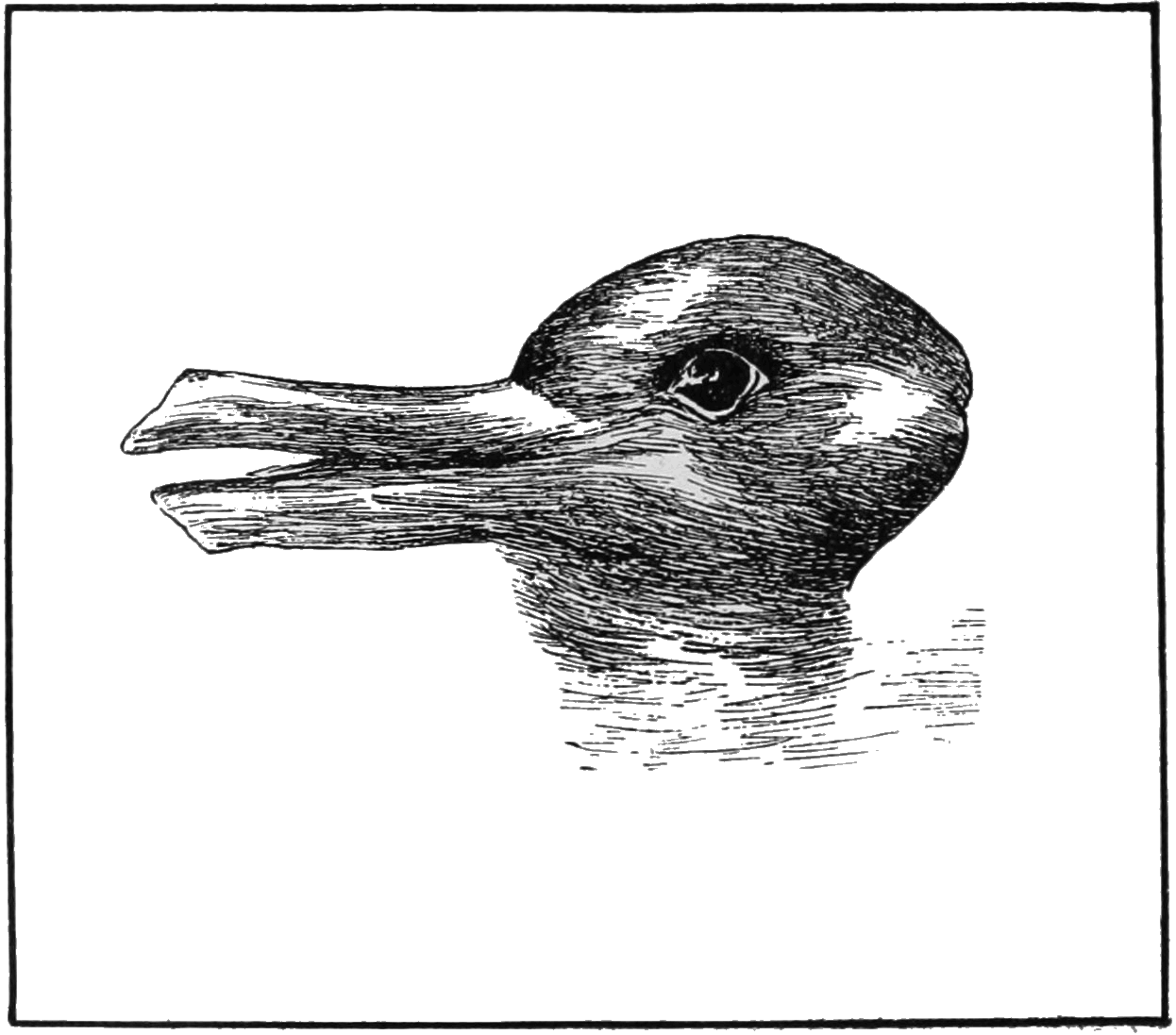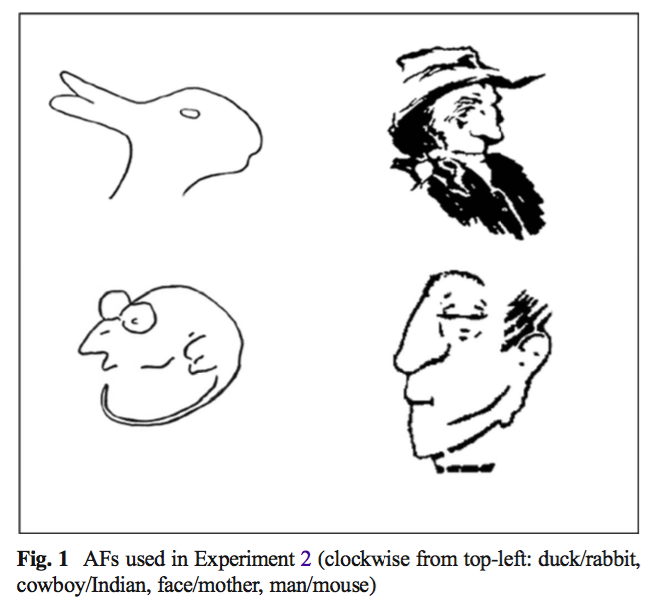Our perception of the world is flexible and depends on our expectations, our experience, and on cues around us. Ambiguous images, whose identity can change depending on our interpretation, offer a striking illustration of this flexibility.
Perhaps the best-known and best-studied ambiguous image is the rabbit-duck, first brought to psychologists’ attention by Jastrow in 1899. As he described it, ambiguous figures demonstrate that “seeing is not wholly an objective matter depending upon what there is to be seen, but is very considerably a subjective matter depending upon the eye that sees.”
Since then, this and other ambiguous images have been used to study the flexibility of perception.
While this image is likely one that you’ve seen before, what animal do you see first this time in the figure below, the rabbit or the duck? And is this perception stable or does the figure flip back and forth? We’ll get back to this particular figure later in the post, so don’t forget your responses!

Being able to experience the ambiguity of a figure like the rabbit-duck requires experience and maturation. Three- and four- year old children don’t spontaneously reverse ambiguous figures, and only develop this ability somewhere between the ages of four and five. This may be because figure reversal relies on the development of inhibitory control, which also takes place around this time.
Why do we need inhibitory control to reverse ambiguous figures? The idea is that when you switch from seeing an image as one figure (e.g., the rabbit) to another figure (e.g., the duck), you need to inhibit the competing alternative image (rabbit).
Studies on bilingualism support the idea that inhibition is important for figure reversal. Bilingual children tend to have better inhibitory control than monolingual children, presumably due to constant practice inhibiting one language when using the other one. When it comes to ambiguous figures, bilingual children are also at an advantage over monolinguals.
In a recent article published in the Psychonomic Bulletin & Review, researchers Marina Wimmer, Steven Stirk, and Peter Hancock examined the role that inhibitory control plays in adults’ ability to reverse ambiguous figures.
Specifically, they tested whether “depleting” people’s cognitive resources (in this case, inhibition) would hinder their ability to flexibly reverse ambiguous figures.
The researchers used the ego depletion paradigm (see also: the recent replication study on ego depletion). In this paradigm, participants need to inhibit an automatic response over and over… and over and over… and over. The idea is that after some time, one’s “ego” is depleted by the constant effort expended on inhibiting an automatic response.
Wimmer and colleagues presented participants with a page from a neuroscience article, and participants were asked to cross off the letter E. In the control condition, participants were asked to cross off all instances of the letter. Every time they saw an E, they could cross it off.
Participants in the depletion condition had additional constraints. They were told to only cross of an E if it was “not adjacent to another vowel and more than one letter away from another vowel”. This version of the task relied on inhibitory control because participants couldn’t automatically cross off any E they saw. Instead, they had to stop and consider whether each E fit the criteria or not. And after doing this for a page-full of E’s their inhibitory control was probably pretty depleted…
After completing the ego depletion or control task, Wimmer and colleagues measured participants’ performance on a standard measure of inhibitory control: the Stroop task. (Which we have discussed previously on several occasions.)
Participants were presented with color words that appeared in different colors (e.g., GREEN written in green font, BLUE written in red font) and identified what color each word was written in—not the color the word spelled out. This task required participants to inhibit their automatic responses (e.g., responding RED when the named color is RED). The figure below shows a typical stimulus:

The measure of interest was the difference between participants’ response time on inhibition trials (e.g., BLUE written in red) and control task trials that didn’t require inhibition (the word and color ink were congruent). As predicted, ego-depleted participants showed lower inhibitory control than control participants.
The researchers then tested whether the same ego depletion task would affect people’s ability to reverse ambiguous figures. Given that the ego-depletion impacted inhibitory control and inhibitory control is needed for figure reversal, ego-depleted participants were predicted to have more difficulty reversing ambiguous figures.
In this experiment, participants first completed the ego depletion or control task and were then shown four ambiguous figures, including the classic duck/rabbit, as shown in the figure below.

Participants looked at each image for a minute and reported every time they saw the figure change. The researchers measured when and how often these reversals occurred. Next, participants were informed of the two possible interpretations of each image and again looked at each one for one minute and reported when they saw the figure change.
When naïve to the ambiguity of the images, ego-depleted participants tended to take longer to report a reversal and reported fewer reversals overall than did the control participants. Once everyone was informed of the image ambiguity, ego-depleted participants still reported fewer reversals during the subsequent viewing period than did control participants.
These findings suggest that inhibitory control impacts our perceptual flexibility. After doing a task that drained inhibitory control, people showed less flexibility in their perception of ambiguous figures.
Going back to the rabbit/duck figure, how much did you experience the figures reversing? The degree to which you’re able to flip back and forth may have something to do with where you are in your day. Are you depleted and reading this during a break? Or is it the morning, and you’re fresh and cycling through those bunnies and duckies without a problem?
Beyond flexibility, environmental cues can further shape how ambiguous figures are seen. One such environmental cue for the rabbit/duck figure is time of year. In a charming study, Brugger and Brugger demonstrated that people are more likely to see the figure as a rabbit on Easter, and more likely to see it as a bird in the fall, perhaps due to the autumn bird migration. Did you see the image at the start of the article as a rabbit? With Easter coming up and stores filled with chocolate bunnies, stuffed bunnies, and bunny ears, this may have been unavoidable.
Article focused on in this post:
Wimmer, M. C., Stirk, S., & Hancock, P. J. B. (2017). Ego depletion in visual perception: Ego-depleted viewers experience less ambiguous figure reversal. Psychonomic Bulletin & Review. DOI: 10.3758/s13423-017-1247-2.
